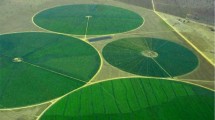Abstract
Optimization by simulation of agricultural practices can help to improve irrigation water use efficiency. This work introduces an efficient hierarchical decomposition method to design irrigation management strategies that is modeled as a continuous stochastic problem. Various combinations of selection (greedy, Pareto-based), division (middle, pivot, maximization) and evaluation techniques (global, standard deviation) were tested. We present results of an 8-continuous-parameter irrigation strategies design. Two criteria were chosen to evaluate the different combinations: the achieved direct margin, and the number of simulation runs that were needed to reach it. Selection techniques impacted the resolution time, while the evaluation techniques impacted the direct margin efficiency. Based on the two former criteria, the trade-off combination of greedy selection, pivot partition and average value evaluation appeared to be the most efficient to design irrigation strategies.












Similar content being viewed by others
Notes
See for example Ehrgott (2005) for dominance definitions.
References
Andradóttir S (1998) A review of simulation optimization techniques. In: Proccedings of the 1998 winter simulation conference, pp 151–158
Aubry C, Papy F, Capillon A (1998) Modelling decision-making processes for annual crop management. Agric Syst 56(1):45–65
Bergez JE, Debaeke P, Deumier J, Lacroix B, Leenhardt D, Leroy P, Wallach D (2001a) Moderato: an object-oriented decision tool for designing maize irrigation schedules. Ecol Model 137:43–60
Bergez JE, Eigenraam M, Garcia F (2001b) Comparison between dynamic programming and reinforcement learning: a case study on maize irrigation management. In: Proceedings of the 3rd European conference on information technology in agriculture (EFITA-01), Montpellier (FR), pp 343–348
Bergez JE, Garcia F, Lapasse L (2004) A hierarchical partitioning method for optimizing irrigation strategies. Agric Syst 80:235–253
Bergez JE, Garcia F, Wallach D (2006) Representing and optimizing management decisions with crop models. In: Wallach D, Makovski D, Jones JW (eds) Working with dynamic crop models: evaluation, analysis, parameterization, and applications. Elsevier Science, Amsterdam, pp 173–207
Breiman L (1996) Technical note: some properties of splitting criteria. Mach Learn 24(1):41–47
Ehrgott M (2005) Multicriteria optimization. Springer, New York
FAO MG (2002) Water: precious and finite resource. Tech. rep., Food and Agriculture Organization of the United Nations
Fu M, Glover F, April J (2005) Simulation optimization: a review, new developments, and applications. In: Proceedings of the 2005 winter simulation conference, pp 83–95
Huyer W, Neumaier A (1999) Global optimization by multilevel coordinate search. J Glob Optim 14(4):331–355
Jones D, Perttunen C, Stuckman B (1993) Lipschitzian optimization without the Lipschitz constant. J Optim Theory Appl 79(1):157–181
Norkin V, Ermoliev Y, Ruszczynski A (1994) On optimal allocation of indivisibles under uncertainty. Oper Res 46(3):381–395
Ólafsson S, Kim J (2002) Simulation optimization. In: Winter proccedings of the 2002 winter simulation conference, pp 79–84
Papy F (2000) Farm models and decision support: a summary review. Research on agricultural systems: accomplishments, perspective and issues, pp 89–107
Prasetio Y, Yen J, Zabinsky Z (2004) A probabilistic branch-and-bound scheme for simulation optimization. In: INFORMS annual meeting, Denver, USA
Shaffer M, Brodahl M (1998) Rule-based management for simulation in agricultural decision support systems. Comput Electron Agric 21(2):135–152
Smith M (2000) The application of climatic data for planning and management of sustainable rainfed and irrigated crop production. Agric For Meteor 103(1–2):99–108
Wallach D, Goffinet B, Bergez J, Debaeke P, Leenhardt D, Aubertot J (2001) Parameter estimation for crop models a new approach and application to a corn model. Agron J 93(4):757–766
Author information
Authors and Affiliations
Corresponding author
Rights and permissions
About this article
Cite this article
Crespo, O., Bergez, J.E. & Garcia, F. P2 hierarchical decomposition procedure: application to irrigation strategies design. Oper Res Int J 11, 19–39 (2011). https://doi.org/10.1007/s12351-009-0040-z
Received:
Revised:
Accepted:
Published:
Issue Date:
DOI: https://doi.org/10.1007/s12351-009-0040-z




